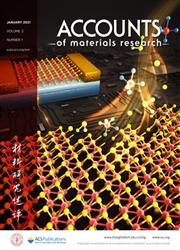Functional Bis/Multimacrocyclic Materials Based on Cycloparaphenylene Carbon Nanorings
IF 14
Q1 CHEMISTRY, MULTIDISCIPLINARY
引用次数: 0
Abstract
Topologically unique nanocarbon materials with optoelectronic potential are both fascinating and challenging synthetic targets. Their distinctive molecular topologies often lead to chirality, unique optoelectronic properties, and encapsulation capabilities, stimulating advances in synthetic chemistry and materials science. The research on curved nanocarbon materials has garnered substantial interest due to the intricate relationship between their π-conjugation and molecular geometry, as well as their emerging applications in various fields. The introduction of curvature significantly affects the redox behaviors, optical properties, charge-transport capabilities, and self-assembly processes of these nanocarbon materials. The representative examples of curved aromatic systems are cycloparaphenylenes (CPPs) and related carbon nanorings. In these molecules, the nonplanar aromatic structures can induce unique radial π-conjugation and further endow them with distinctive photophysical properties. By adjusting the number of benzene rings in a CPP or incorporating diverse polycyclic aromatic hydrocarbon units, researchers can finely tune the optical and electronic properties of these nanostructures. Many potential applications can be discovered in the fields of fluorescent probes, organic light-emitting diodes (OLEDs), and optoelectronic devices. These properties establish CPP as an important scaffold to create novel carbon nanostructures. With the ongoing advancements in molecular topology, new opportunities are emerging within the fields of materials science, molecular electronics, and biomedicine. Given the exceptional electronic and photophysical properties of CPPs, there has been considerable interest in the development of topologically intriguing bis/multimacrocyclic architectures. It is anticipated that high dimensionality and unexplored topologies will endow these bis/multimacrocycles with unparalleled physical and chemical properties. This concise Account highlights recent developments from our research group on topologically functional materials based on CPP carbon nanorings, particularly their potential applications. Our discussion focuses on (i) the design and synthesis of a series of fully sp2-hybridized all-benzenoid bismacrocycles, as well as [n]cycloparaphenylene-pillar[5]arene bismacrocycles; (ii) the construction of all-CPP-based long π-extended polymeric segments of the armchair SWCNT; and (iii) the synthesis of CPP-based mechanically interlocked molecules, specifically [12]CPP-[3]catenane. Structures like these CPP-based bis/multimacrocyclic architectures exhibit distinct properties─including radial π-conjugation, supramolecular properties, chirality, and unexpected dual-emissive and anti-Kasha photophysical characteristics due to their nonplanar geometries─that allow precise tuning of their HOMO–LUMO gap, emission profiles, and charge-transport behaviors. These properties make them promising for applications in OLEDs, circularly polarized luminescence (CPL) materials, lithium-ion batteries (LIBs), and photoelectroactive devices. By discussing recent work, we demonstrate the potential of these carbon nanorings for future technologies in optoelectronics, chiroptics, and nanotechnology. We also discuss challenges and future directions, emphasizing the importance of precise control over the size, shape, and conjugation of these topological structures to broaden their applications in molecular machines, sensors, and functional materials.

基于环对苯碳纳米环的双/多环功能化材料
拓扑结构独特且具有光电潜力的纳米碳材料是一种极具吸引力和挑战性的合成目标。其独特的分子拓扑结构通常导致手性,独特的光电性质和封装能力,刺激合成化学和材料科学的进步。弯曲纳米碳材料由于其π共轭关系与分子几何结构之间的复杂关系以及在各个领域的应用而引起了人们极大的兴趣。曲率的引入显著影响了这些纳米碳材料的氧化还原行为、光学性质、电荷输运能力和自组装过程。弯曲芳香体系的典型例子是环对苯乙烯(CPPs)和相关的碳纳米结构。在这些分子中,非平面芳族结构可以诱导独特的径向π共轭,从而赋予它们独特的光物理性质。通过调整CPP中苯环的数量或加入不同的多环芳烃单元,研究人员可以精细地调整这些纳米结构的光学和电子特性。在荧光探针、有机发光二极管(oled)和光电子器件领域可以发现许多潜在的应用。这些特性使CPP成为制造新型碳纳米结构的重要支架。随着分子拓扑学的不断进步,材料科学、分子电子学和生物医学领域出现了新的机会。鉴于CPPs特殊的电子和光物理性质,人们对开发拓扑上有趣的双/多环结构非常感兴趣。预计高维和未开发的拓扑结构将赋予这些双/多宏循环无与伦比的物理和化学性质。本文简要介绍了我们研究小组在基于CPP碳纳米结构的拓扑功能材料方面的最新进展,特别是它们的潜在应用。我们的讨论集中在(i)设计和合成一系列完全sp2杂化的全苯双大环,以及[n]环对苯乙烯-柱[5]芳烃双大环;(ii)扶手椅型swcnts的全磷酸基长π延伸聚合物段的构建;(iii)合成基于CPP的机械连锁分子,特别是[12]CPP-[3]链烷。像这些基于cpp的双/多环结构具有独特的性质──包括径向π共轭、超分子性质、手性,以及由于其非平面几何形状而导致的意想不到的双发射和反卡沙光物理特性──允许精确调整其HOMO-LUMO间隙、发射曲线和电荷输运行为。这些特性使它们在oled、圆极化发光(CPL)材料、锂离子电池(lib)和光电活性器件中的应用前景广阔。通过讨论最近的工作,我们展示了这些碳纳米材料在光电子学、热学和纳米技术的未来技术中的潜力。我们还讨论了挑战和未来的方向,强调了精确控制这些拓扑结构的大小、形状和共轭的重要性,以扩大它们在分子机器、传感器和功能材料中的应用。
本文章由计算机程序翻译,如有差异,请以英文原文为准。
求助全文
约1分钟内获得全文
求助全文

 求助内容:
求助内容: 应助结果提醒方式:
应助结果提醒方式:


